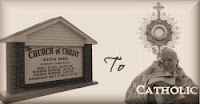 The Church, too, has seasons and colors to match which greatly appeal to the visual senses. These colors vary depending on the liturgical season we are in, and are most commonly seen on priestly vestments, but are also seen in other cloths and sometimes candles used at mass.
The Church, too, has seasons and colors to match which greatly appeal to the visual senses. These colors vary depending on the liturgical season we are in, and are most commonly seen on priestly vestments, but are also seen in other cloths and sometimes candles used at mass.There are five main liturgical colors in the Roman Rite: white, red, green, violet, and black, although black has greatly fallen out of use for funerals, commonly replaced nowadays by white or violet.
Gold may sometimes be used rather than white, and there is also rose that is allowed on Gaudete Sunday and Laetare Sunday, both of which are joyful Sundays in the middle of the penitential seasons when we get a small break from the penitential focus and do some restrained rejoicing that the Lord's coming (either through His Birth at Christmas or His Resurrection at Easter) is getting near!
The meanings behind the various colors are as follows (text taken from the Catholic Encyclopedia):
The variety of liturgical colours in the Church arose from the mystical meaning attached to them.
WHITE
 Thus white, the symbol of light, typifies innocence and purity, joy and glory. (Gold may also be used)
Thus white, the symbol of light, typifies innocence and purity, joy and glory. (Gold may also be used)White is the colour proper to Trinity Sunday, the feasts of Our Lord, except those of His Passion, the feasts of the Blessed Virgin, angels, confessors, virgins and women, who are not martyrs, the Nativity of St. John the Baptist, the chief feast of St. John the Evangelist, the feast of the Chains and of the Chair of St. Peter, the Conversion of St. Paul, All Saints, to consecration of churches and altars, the anniversaries of the election and coronation of the pope and of the election and consecration of bishops; also for the octaves of these feasts and the Offices de tempore from Holy Saturday to the vigil of Pentecost; it is used for votive Masses when the feasts have white, and for the nuptial Mass; also in services in connection with the Blessed Sacrament, at the burial of children, in the administration of baptism, Holy Viaticum, and matrimony.
RED
 Red, the language of fire and blood, indicates burning charity and the martyrs' generous sacrifice.
Red, the language of fire and blood, indicates burning charity and the martyrs' generous sacrifice.Red is used the week of Pentecost, on the feasts of Christ's Passion and His Precious Blood, the Finding and Elevation of the Cross, the feasts of Apostles and martyrs; and in votive Masses of these feasts. It is used on Holy Innocents if the feast occur on Sunday and always on its octave.
GREEN

Green, the hue of plants and trees, bespeaks the hope of life eternal.
Green is employed in Offices de tempore from the octave of the Epiphany to Septuagesima, and from the octave of Pentecost to Advent, except on ember-days and vigils during that time, and on Sundays occurring within an octave.
VIOLET
 Violet, the gloomy cast of the mortified, denotes affliction and melancholy.
Violet, the gloomy cast of the mortified, denotes affliction and melancholy.Violet is used during Advent and from Septuagesima to Easter, on vigils that are fast days, and on ember-days, except the vigil of Pentecost and the ember-days during the octave of Pentecost. Violet is also used for Mass on rogation-days, for votive Masses of the Passion and of penitential character, at the blessing of candles and of holy water. The stole used in the administration of penance and of extreme unction and in the first part of the baptismal ceremonies must be violet.
BLACK

Black, the universal emblem of mourning, signifies the sorrow of death and the sombreness of the tomb.
Black is used in offices for the dead, and on Good Friday.



4 comments:
I'm really enjoying these posts, although "The Light of Christ" was a little too small for me to read ;)
Oh did it show up small on your computer? I'm going to have to have Camille help me figure out what's wrong...it's fine on both our home computers, but he noticed it was super small on one of his computers at work (I think using Firefox.) Sorry about that!
Yeah I'm using Google Chrome - maybe that makes a difference somehow.
What is the source for the image of the priests in red vestments and for the last image of black vestments?
Post a Comment